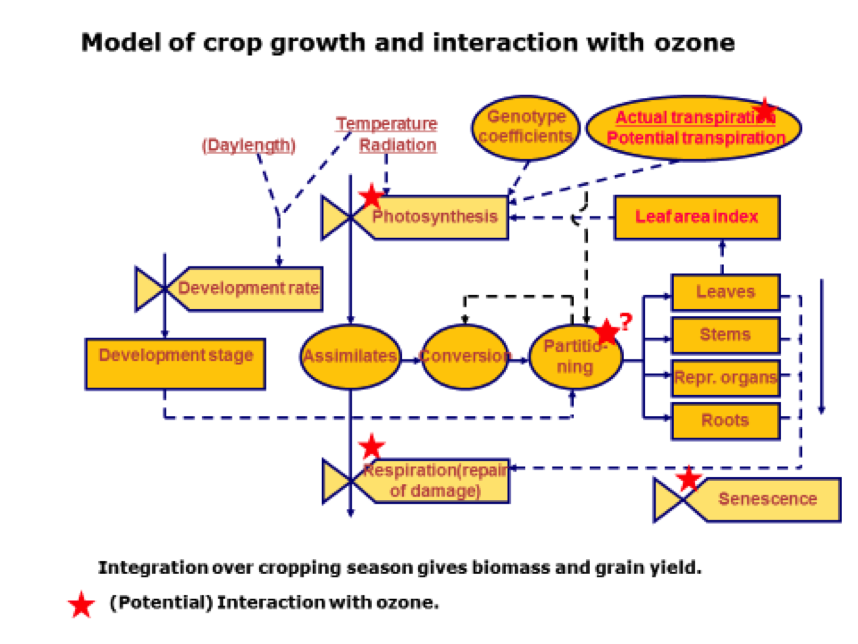Ozone
Main Contacts for Initiative
Frank Dentener, Frank Ewert, Lisa Emberson, and Maurits van den Berg
Brief Description of Activity
The AgMIP ozone group initiated an activity to share information on the development of models capable of estimating the effect of ozone on crop growth and yield, and its interplay with other growth limiting factors. The activity brings together ozone-impact and crop-modelling experts, designs joint modelling protocols and experiments, and collects calibration and evaluation empirical data.
Overview of Participants
8 ozone effects crop scientists/groups; and 5-10 crop modellers (tbc) 3 scientists/groups involved in policy to develop emission reductions of ozone precursors within UNECE CLRTAP (Convention on Long Range Transboundary Air Pollution)

Current Research Focus
Recent Noteworthy Finding
Ozone is the most damaging air pollutant to vegetation due to its phytotoxicityand prevalence at high concentrations over important rural/agricultural regions. To understand the scale of the problem, and the effectiveness of policy to reduce emissions of ozone precursors, requires global crop modelling efforts. The calibration and evaluation of such crop models using empirical datasets is imperative to give confidence to risk assessments to inform policy.
Recent Papers/Reports
Emberson, L.D., Pleijel,, H., Ainsworth, E.A., van den Berg, M., Ren, W., Osborne, S., Mills, G., Pandey, D., Dentener, D., Büker, P., Ewert, F., Koeble, R., Van Dingenen,R. (submitted) Ozone effects on crops and consideration in crop models. European journal of Agronomy.
Protocol for O3 modelling intercomparison, Maioranoet al, 2018.
Prior Updates
 Main Contacts for Initiative
Main Contacts for Initiative
Frank Dentine, Frank Ewert, Lisa Emberson, and
Maurits van den Berg.
Ozone-crop growth interactions
There is a wealth of evidence that ozone is phytotoxic to plants, and can cause substantial damage to crops1. Model based assessments suggest large impact on crop yields2,3,4,5, both globally and in specific regions, and multiple interactions with climate change impact, adaptation and mitigation actions. A key concern for crop modeling is that the effects of ozone pollution are currently not considered in most crop models and therefore ozone effects are excluded from estimates of regional global crop growth and yield. A particular gap in our understanding is how ozone interacts with other stresses that effect crop growth, such as soil fertility, CO2 fertilization, soil water stress, heat stress and even pests and diseases (e.g. ozone has been shown to pre-dispose crops to attack by pests such as red spider mite). Nevertheless, there is sufficient information on the effect of ozone on crop physiology, particularly how it influences photosynthesis, C allocation and early senescence to warrant the development of ozone modules that could be embedded within existing crop models.

The AgMIP ozone-crop group initiated an activity to share information on the development of ozone-crop growth, bring together ozone impact and crop experts, design joint model experiments, and collect and provide calibration data.
The ozone-crop group held a first workshop in Montpellier (1st of July, 2016; see report), and intends to set up a first modeling exercise starting in autumn 2016. Further details will be published on this site.
References
- Mills G, et al. (2007) A synthesis of AOT40-based response functions and critical levels of ozone for agricultural and horticultural crops. Atmos Environ 41(12):2630–2643.
- R. Van Dingenen, F.J. Dentener, F. Raes, M.C. Krol, L. Emberson, J.Cofal The global impact of ozone on agricultural crop yields under current and future air quality legislation, Atmos. Env, 43 (3), p. 605-618, 2009.
- Burney J. and Ramanatan, Recent climate and air pollution impacts on Indian agriculture, PNAS, 2014.
- Tai Amos P. K, M. Val Martin and C.L. Heald Threat to future global food security from climate change and ozone air pollution. NATURE CLIMATE CHANGE, 2014
- Tian et al., Climate extremes and ozone pollution: a growing threat to China’s food security Ecosystem Health and Sustainability, 2, 1-9, 2016. DOI: 10.1002/ehs2.1203
